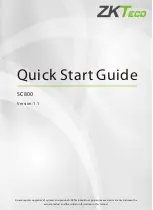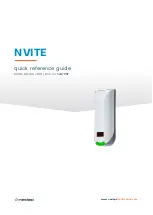
47
ENG
Hecu
C
O
2
+0300085EN rel. 2.2 - 07.05.2019
8. SIGNALS AND ALARMS
Hecu CO2 can manage both alarms relating to the status of the digital
inputs and to system operation. For each alarm, the following are
controlled:
•
Actions on the devices, if necessary
•
Output relays (one global and two with diff erent priorities, if confi gured)
•
The red LED on the terminal and the buzzer, where featured
•
The type of acknowledgement (automatic, manual, semi-automatic)
•
Any activation delay
The complete list of alarms, with the related information as described
above, is available in the Alarm table.
8.1 Alarm
management
All alarms feature the following behaviour:
•
When an alarm is activated, the red LED fl ashes and the buzzer is
activated (where featured); the relay corresponding to the global alarm
and any alarms with high priority is activated (if confi gured)
•
Pressing
(Alarm), the red LED stays on steady, the buzzer is muted
and the alarm screen is shown
•
If there is more than one active alarm, these can be scrolled using
(Up)
(Down). This situation is signalled by an arrow at the bottom
right on the screen
•
Press
(Alarm) again for at least 3 seconds manually acknowledges
the alarms, which are cleared from the display unless others are active
(they are saved in the log)
Priority
For certain alarms, the alarm output relays can be confi gured according
to two types of priority:
•
R1: serious alarm
•
R2: normal alarm
The corresponding relays, once confi gured, are activated when an alarm
with the corresponding priority occurs. For other alarms, priority is fi xed
and associated by default to one of the two relays.
Reset/acknowledgement
The alarms can be acknowledged manually, automatically or semi-
automatically:
•
Manual: the alarm is acknowledged by pressing
(Alarm), twice,
the fi rst time displays the corresponding alarm screen and mutes the
buzzer, the second (extended, for at least 3 seconds) cancels the alarm
(which is saved in the log). If the alarm is still active, it is not reset and
the signal is shown again.
•
Automatic: when the alarm condition ceases, the alarm is automatically
acknowledged, the LED comes on steady and the corresponding
screen remains displayed until
(Alarm) is pressed and held; the
alarm is saved in the log.
•
Semi-automatic: the alarm is acknowledged automatically, until
reaching a maximum number of activations in a set period. When the
number reaches the maximum setting, the alarm then needs to be
acknowledged manually.
For manual acknowledgement, the functions associated with the alarm
will not be reactivated until the alarm is acknowledged , while for
automatic acknowledgement, the functions are reactivated as soon as
the alarm condition ceases.
Log
The alarm log can be accessed:
•
from branch H.a of the main menu
•
by pressing
(Alarm) and then
(Enter) when there are no active
alarms
•
by pressing
(Enter). After having scrolled all of the alarms.
The alarm log screens show:
1.
Order of activation (no. 01 is the oldest alarm)
2.
Time and date the alarm was activated
3.
Short description
4.
Main values at the moment the alarm occurred (suction pressure and
condensing pressure)
Note:
a maximum of 50 alarms can be logged; after this limit any
new events overwrite the oldest ones, which are therefore deleted.
8.2 Compressor
alarms
The number of alarms can be chosen for each compressor, in the
confi guration phase (wizard) or subsequently in branch C.a.e of the main
menu.
Fig. 8.a
After having selected the number of alarms (maximum 2), each alarm
can be assigned a description, choosing from the options shown in the
table, output relay, type of reset, delay and priority. The eff ect of the alarm
on the devices is fi xed and involves stopping the compressor, except for
the oil warning.
Possible descriptions for compressor alarms
Reciprocating or scroll
Generic
Overload
High pressure
Low pressure
Oil
Tab. 8.a
A possible screen for choosing the description of the alarm is shown in
the fi gure:
Tab. 8.b
After having selected the ‘generic’ description, no other description can
be selected. In general, the descriptions are divided into 4 groups:
•
generic
•
others (overload, oil, high pressure, low pressure)
Summary of Contents for Hecu CO2
Page 2: ......
Page 4: ...4 ENG Hecu CO2 0300085EN rel 2 2 07 05 2019...
Page 6: ......
Page 61: ...61 ENG Hecu CO2 0300085EN rel 2 2 07 05 2019 9 2 Software revision history New version 3 0 012...
Page 62: ...62 ENG Hecu CO2 0300085EN rel 2 2 07 05 2019 Notes...
Page 63: ......
















































